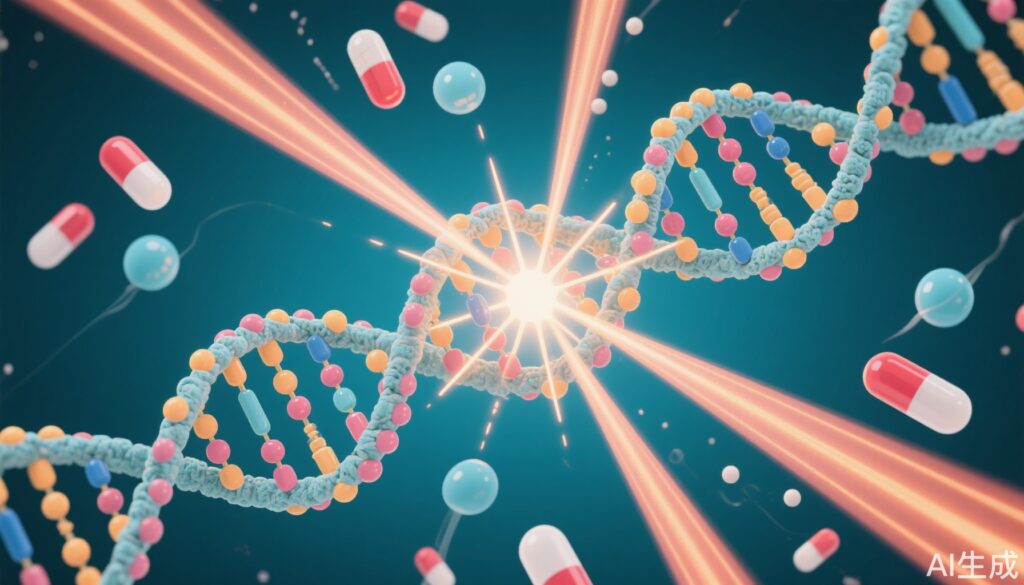Highlight
- Cancer treatments, particularly radiotherapy, and genetic predisposition significantly contribute to the risk of subsequent neoplasms (SNs) in childhood cancer survivors.
- Polygenic risk scores (PRSs) quantify genetic susceptibility, showing notable impact on SN risk, especially for thyroid cancer.
- Lifestyle factors such as smoking, alcohol, obesity, physical activity, and diet have minimal influence on SN risk compared to genetic and treatment-related factors.
- These findings emphasize the need for tailored risk assessment and surveillance strategies incorporating both treatment exposure and genetic risk.
Study Background and Disease Burden
Childhood cancer survival rates have improved dramatically due to advances in multimodal therapies, including surgery, chemotherapy, and radiotherapy. However, survivors face long-term health challenges, notably an elevated risk of subsequent neoplasms (SNs), which are new primary cancers distinct from the original malignancy. SNs represent a major cause of morbidity and mortality in this population, often emerging decades after initial treatment. Both exposure to cancer therapies and inherited genetic factors are implicated in SN development. Yet, quantifying the relative contributions of these factors to the overall SN burden remains a critical knowledge gap. Understanding this balance is essential to optimize follow-up care, personalize surveillance, and potentially mitigate SN risk.
Study Design
This investigation analyzed data from two large, well-characterized cohorts of childhood cancer survivors with long-term follow-up: the St Jude Lifetime Cohort (SJLIFE) and the Childhood Cancer Survivor Study (CCSS). The cohorts comprised 4,401 and 7,943 participants respectively, totaling 12,344 survivors. Data included detailed treatment histories, genetic information, lifestyle factors, and incident SN outcomes.
The study employed multivariable piecewise-exponential models to calculate attributable fractions, estimating the proportion of SN cases due to exposures. Genetic predisposition was assessed using polygenic risk scores (PRSs), comparing participants in the upper two tertiles of risk against the lowest tertile based on general population data for each SN type. Lifestyle factors analyzed included physical activity, smoking, alcohol consumption, obesity, and diet. The primary endpoint was the first occurrence of a subsequent neoplasm.
Key Findings
The study population had a median attained age of 33.0 years (SJLIFE) and 36.0 years (CCSS), with nearly equal gender distribution and predominantly White ethnicity (88.4%). Median follow-up from primary cancer diagnosis was over two decades in both cohorts, enabling robust long-term risk assessment.
Cancer treatments and genetic predisposition together accounted for a substantial proportion of incident SNs, with attributable fractions varying by tumor type. For example, treatment and genetic risk explained 30% (95% CI 6-49) of sarcomas and up to 92% (89-94) of meningiomas. Radiotherapy exposure had the highest contribution, particularly in survivors aged 35 years or older (44.7% attributable fraction), compared to younger survivors (40.0%).
Genetic risk, as measured by PRSs, contributed significantly to SN risk, ranging from 1% (meningioma) to 52% (thyroid cancer), and surpassed chemotherapy contributions for certain SN types. Chemotherapy accounted for 3% to 35% of attributable SN risk depending on tumor type. Lifestyle factors had negligible attributable fractions, suggesting minimal impact on SN incidence in this population.
Expert Commentary
These findings underscore the dominant role of treatment exposure and genetic susceptibility in the etiology of SNs among childhood cancer survivors. The pronounced impact of radiotherapy aligns with known carcinogenic effects of ionizing radiation on normal tissues. The integration of polygenic risk scores represents a significant advance, enabling more precise genetic risk stratification beyond monogenic syndromes.
While lifestyle interventions are vital for overall health, their limited influence on SN risk highlights the importance of focusing surveillance efforts on those with high treatment and genetic risk. The study’s large sample size, extended follow-up, and comprehensive data enhance confidence in the results. However, generalizability to more ethnically diverse populations requires further research.
Mechanistically, genetic variants captured by PRSs likely modulate DNA repair capacity, immune surveillance, and susceptibility to mutagenic effects of therapy. Future studies might explore gene-environment interactions and the utility of PRSs in clinical risk prediction models.
Conclusion
This landmark study from the St Jude Lifetime Cohort and Childhood Cancer Survivor Study demonstrates that subsequent neoplasms in childhood cancer survivors are predominantly driven by prior cancer treatments—especially radiotherapy—and inherited genetic predisposition, with lifestyle factors playing a minimal role. These insights emphasize the necessity of integrating detailed treatment histories and genetic risk profiling into personalized survivorship care. Tailored surveillance protocols can facilitate early detection and intervention, ultimately improving long-term outcomes for this vulnerable population. Ongoing research into genetic risk mechanisms and preventive strategies remains imperative.
References
Neupane A, Liu Q, Taneja S, French J, Ehrhardt MJ, Brinkman TM, Webster R, Yang JJ, Im C, Turcotte LM, Neglia JP, Gramatges MM, Howell RM, Bhatia S, Ness KK, Hudson MM, Armstrong GT, Robison LL, Yasui Y, Sapkota Y. Contributions of cancer treatment and genetic predisposition to risk of subsequent neoplasms in long-term survivors of childhood cancer: a report from the St Jude Lifetime Cohort and the Childhood Cancer Survivor Study. Lancet Oncol. 2025 Jun;26(6):806-816. doi: 10.1016/S1470-2045(25)00157-3. PMID: 40449499; PMCID: PMC12204326.



